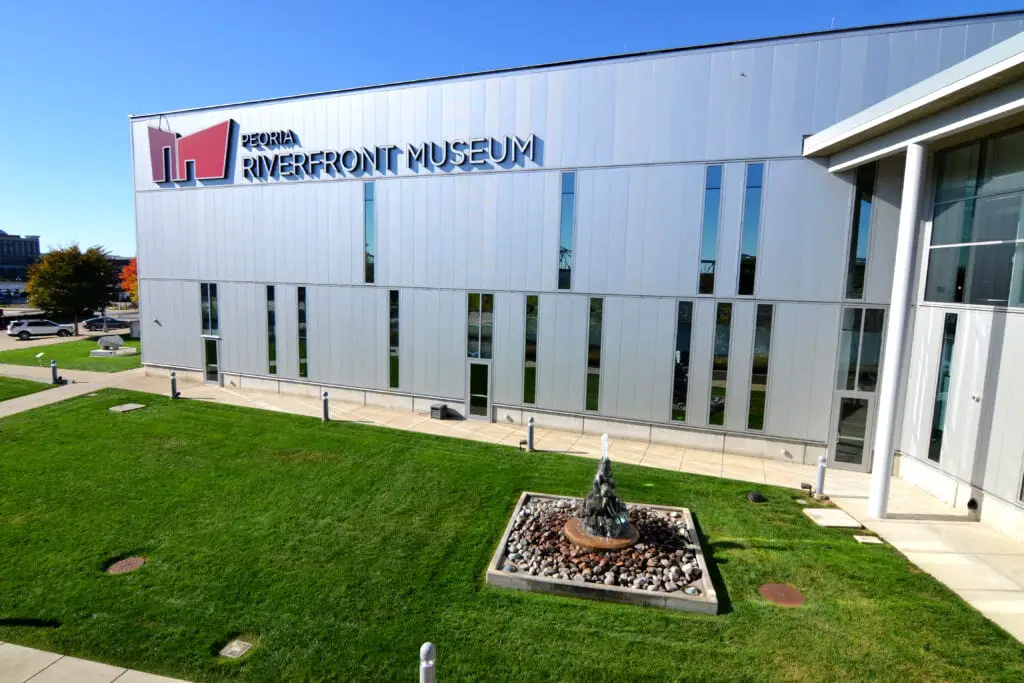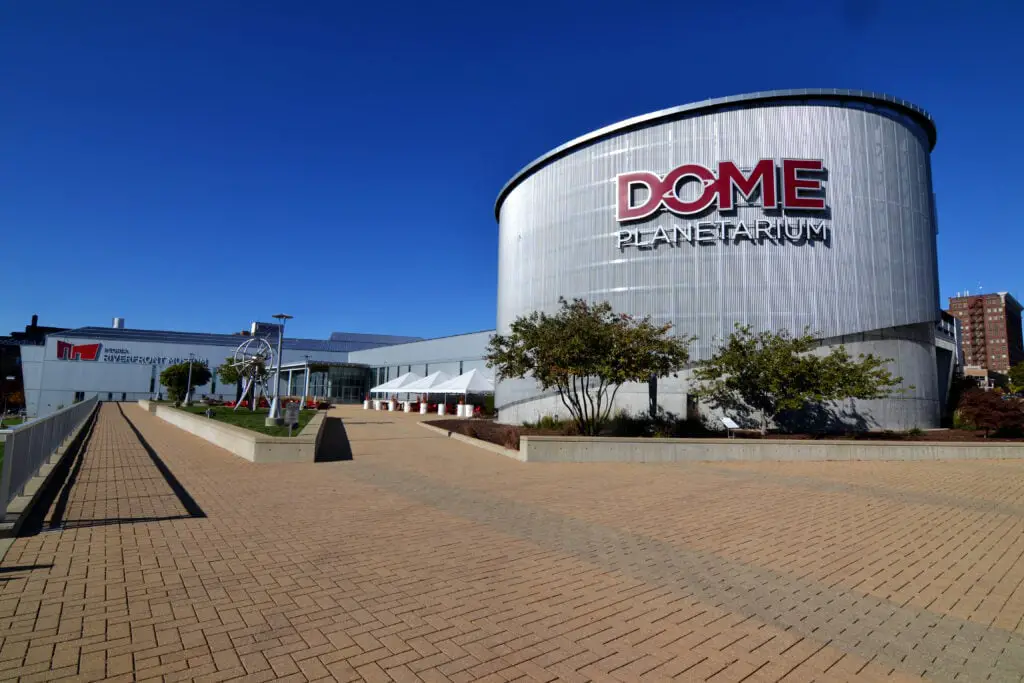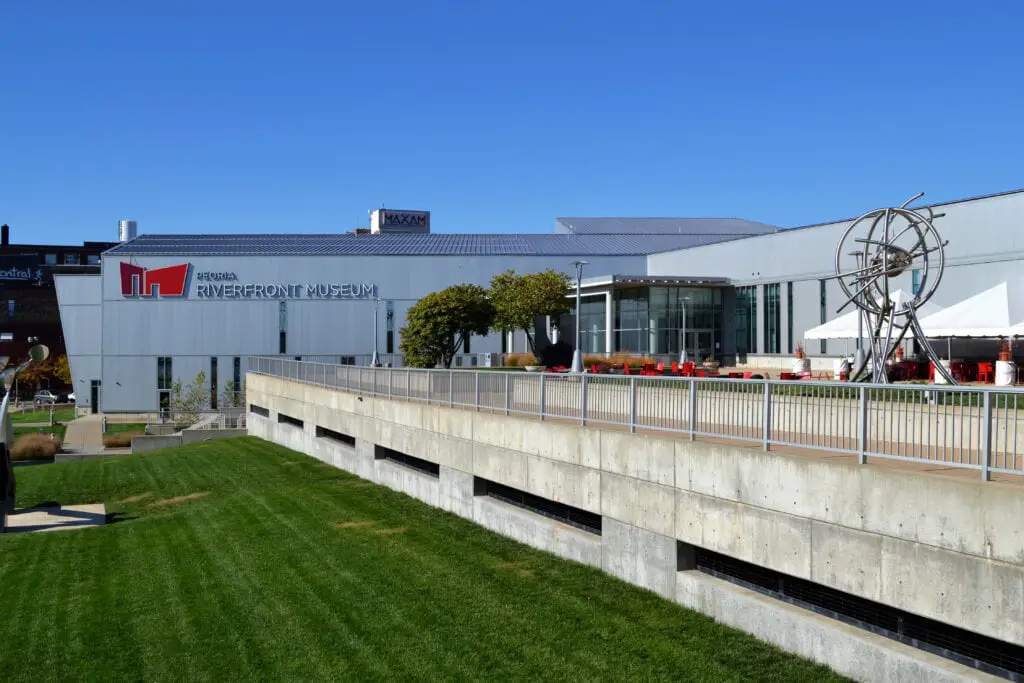Peoria Riverfront Museum: A Visionary Beginning
The journey of the Peoria Riverfront Museum is a tale of transformation and community spirit. It all started back in 2012, on a crisp October day, the 20th to be exact. That's when the doors swung open to a new era of cultural enrichment in Peoria, Illinois.
But let's not get ahead of ourselves; the story begins much earlier, with the Lakeview Museum of Arts & Sciences. Founded in 1965, Lakeview was more than a museum; it was a beacon for the arts and sciences in the heart of Illinois.
Fast forward to the early 2000s, and the winds of change were blowing. The community dreamed bigger, spurred by the need for a more modern facility that could house both art and science under one roof.
Enter the Peoria Riverfront Museum project. This wasn't just about building another museum but crafting a cornerstone for community engagement and education.
The project was a bold move, fueled by private donations and a strong partnership with the County of Peoria. It was a testament to what can happen when a community rallies together for a common goal.
The museum's establishment was a landmark event for the entire region. It signaled a new chapter in the city's commitment to arts, science, history, and achievement.
The public-private partnership model was a game-changer, blending private funding with public support in a way that was both innovative and inclusive.
This model ensured that the museum was a sustainable reality, set to serve future generations. In the heart of Peoria, the museum has become a hub of learning and discovery. It's a place where families, students, and curious minds come to explore and be inspired.
Let's not forget that it's also a fantastic addition to the list of things to do in Peoria, Illinois. The Peoria Riverfront Museum stands as a beacon of progress, symbolizing what's possible when a community comes together to create something truly special.
Architectural Marvel
The Peoria Riverfront Museum is a testament to modern design and environmental stewardship. I think the architects, ZGF (Zimmer Gunsul Frasca) and Dewberry, really outdid themselves here. They've created a space that's a piece of art in itself.
The building, completed in 2012, shines as a beacon of sustainability with its LEED-Gold certification. This structure respects and harmonizes with its environment.
Nestled right next to the historic Rock Island Depot and Freight House, the museum serves as a bridge between Peoria's past and future. The choice of location is no coincidence.
It symbolizes a connection, a continuity of history and modernity, right on the riverfront. With its panoramic views of the Illinois River, this spot adds a whole new layer to the museum experience. It's like history, art, and nature all converge at this one point.
The design elements of the museum are something I find particularly fascinating. The use of natural light, the open spaces, and the fluidity of the interior layout all contribute to an atmosphere that encourages exploration and discovery.
It's about creating an environment that enhances the visitor's experience. The architects really thought about how people interact with space and art.
They've turned the building itself into a silent teacher, educating visitors about architecture, sustainability, and beauty.

A Hub of Diverse Collections
Now, let's explore what truly distinguishes the Peoria Riverfront Museum: its collections. This place is a treasure trove of art, history, science, and culture.
The range is astonishing - from fine art pieces to natural science artifacts. It's like walking through different worlds, each gallery offering a new perspective.
One of the highlights for me has to be the Center for American Decoys. It's such a unique collection, showcasing folk art that tells stories of the past, of the people and the land.
Then there's the Duryea Motor Wagon Company car - a nod to America's automotive history and Peoria's place in it. Not every day do you see a piece of history that has changed how we move.
But what's truly remarkable is the museum's commitment to rotating exhibitions. They've partnered with giants like the Smithsonian and the Art Bridges Foundation, ensuring that there's always something new and exciting on display.
This isn't a museum where you visit once and see it all. It's a dynamic space, constantly evolving, bringing in international blockbusters and hidden gems from its 18,000-object collection. Every visit is a new adventure, a new opportunity to learn and be amazed.
The Dome Planetarium and Giant Screen Theater
I find the Dome Planetarium at the Peoria Riverfront Museum absolutely captivating. Imagine sitting under a 40-foot dome, surrounded by stars and galaxies.
It's like stepping onto a spacecraft and navigating the cosmos. The Digistar 7 technology they use is top-notch, making every celestial show a breathtaking experience. It's an educational journey through space and time.
Then there's the Giant Screen Theater. I hear it's got the largest film society screen in the U.S. That's something, isn't it? Watching a documentary or a feature film there is like being part of the scene.
The 70-foot screen engulfs you, pulling you into the story, the action, the emotion. It's more than watching; it's experiencing cinema in a whole new dimension.
Both the planetarium and the theater are educational powerhouses. They offer programs and shows that make learning about astronomy, history, and science an adventure.
It's a way to ignite curiosity and wonder, not just in kids but in adults too. The museum uses these spaces to blend education with entertainment, making every visit a learning opportunity.

Educational Outreach and Community Engagement
I deeply admire the Peoria Riverfront Museum's educational programs. They offer classes and workshops for all ages and interests.
It's like the museum is a place to grow and learn. The museum covers various topics, from art to zoology, ensuring something for everyone.
One initiative I find particularly commendable is Access for All Days. Every second Sunday, the museum opens its doors for free.
It's a fantastic way to ensure that everyone, regardless of their financial situation, can enjoy and learn from the museum. Education should be accessible to all, and the museum truly stands by this belief.
The museum doesn't stop at its doors. It reaches out into the community, engaging people through various programs and events.
Whether it's a senior morning discussing the latest in science or a family night exploring the arts, the museum always seeks ways to connect with the community. It's a hub of activity, a place where learning never stops, and every visit brings something new and exciting.
The Solar System on Our Doorstep
I think the scale model of the solar system centered around the Peoria Riverfront Museum is a stroke of genius. It's an outdoor adventure stretching across the city.
The museum serves as the sun in this model, with a 46-foot diameter representation that's hard to miss. Then, as you move through Peoria, you encounter the planets, each placed at distances proportional to their positions in space.
Earth, just a 5-inch model, sits 0.94 miles away from the museum, while Neptune is a staggering 28 miles away.
This setup is more than an exhibit; it's a community-wide educational tool. It encourages people to explore the entire city. I find the idea of walking from one planet to another incredibly engaging.

It's a hands-on way to grasp the vastness of our solar system. Plus, it's a great way to get kids and adults alike excited about astronomy and science.
Including dwarf planets and comets in the model adds another layer of learning. It reflects the museum's commitment to education and its effort to keep up with scientific discoveries.
This solar system model turns the whole city into a classroom, making science accessible and fun for everyone.
Fresh Perspectives and New Directions
I find the "FRESH: New Directions in Contemporary Art" exhibition at the Peoria Riverfront Museum particularly exciting. It is a bold move to showcase Robert Colescott's "Miss Liberty" for the first time since its creation in 1980.
The museum pushes boundaries, bringing contemporary issues to the forefront through art. Colescott's work, known for its vibrant colors and thought-provoking themes, fits perfectly into this narrative.
The partnership with the Art Bridges Foundation, initiated in 2019, has transformed the museum's contemporary art scene.
It's not every day that a museum in Peoria gets to display works by artists like Richard Serra and Sherrie Levine.
This collaboration has brought a slice of the global art scene to the local community, making high-quality art accessible to everyone.
"FRESH" is more than an art exhibition; it reflects the museum's evolving identity. It shows a commitment to diversity, dialogue, and education. The museum is not just looking back at history; it's engaging with the present and shaping the future.
This exhibition, running through September 2024, is a testament to the museum's role as a cultural hub, offering new perspectives and challenging visitors to think differently.
